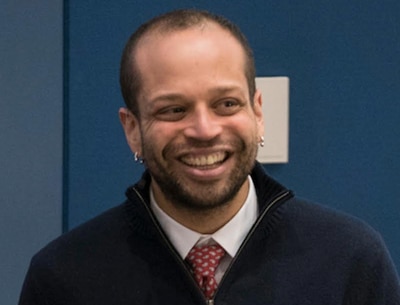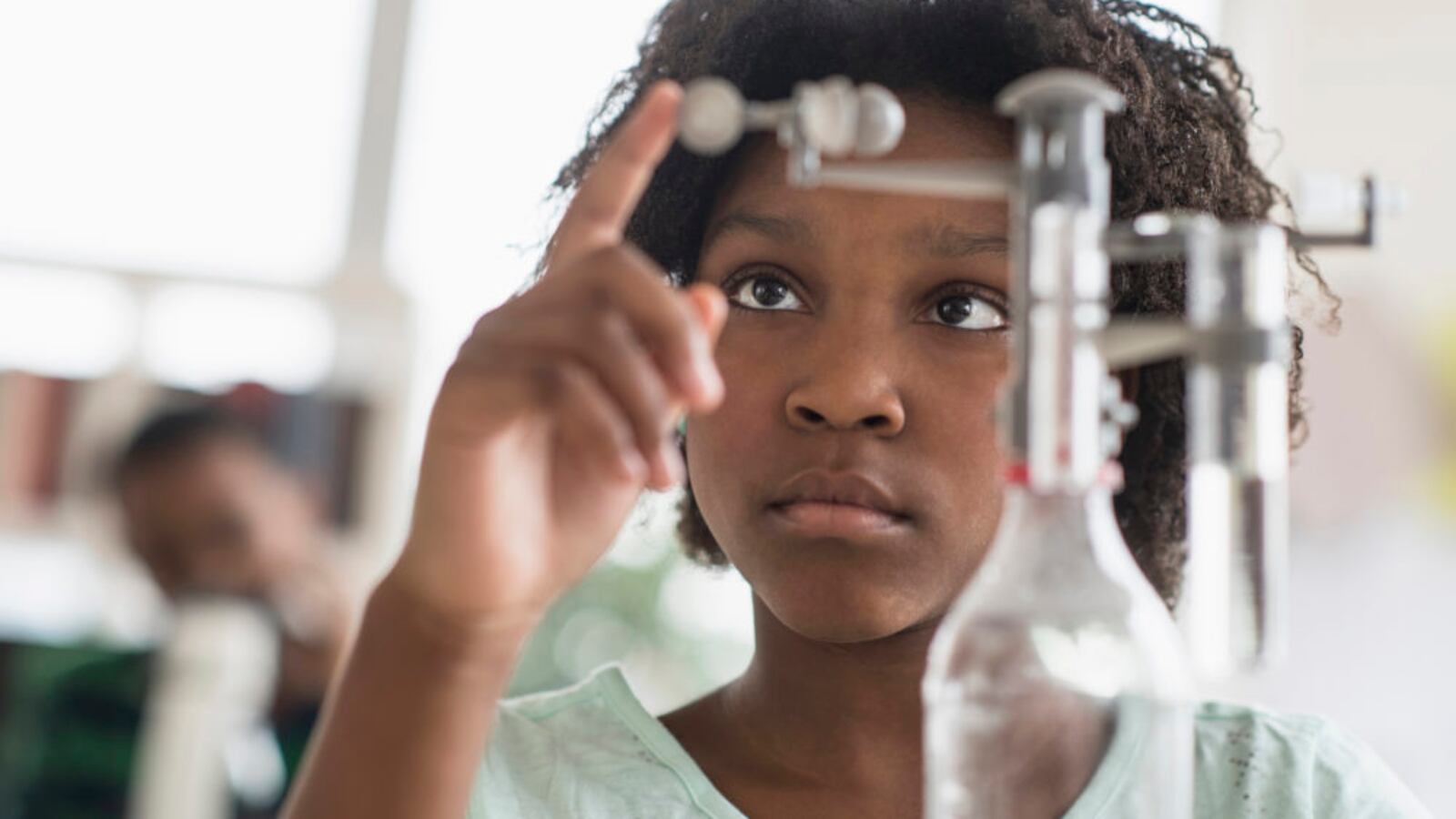When Seth Guiñals-Kupperman was a student at New York City’s Bronx High School of Science more than 20 years ago, he remembers not being impressed with his teachers, despite the school’s elite reputation.
His science classes were “relatively dry” experiences where teachers wrote facts on a blackboard — sometimes with a joke or anecdote about a dead white man — all for regurgitation during an exam. The teaching didn’t seem much more inspired at the Massachusetts Institute of Technology, where Guiñals-Kupperman studied physics, linguistics and philosophy.
“I remember making myself a promise to show my former teachers what they could be doing to captivate their students one day,” Guiñals-Kupperman said.
Now a physics teacher at the Brooklyn Latin School — one of the city’s elite specialized high schools — he’s making good on that promise. Guiñals-Kupperman regularly works with other educators to improve their teaching, and he was recently recognized by Math for America, a non-profit organization devoted to elevating math and science instruction, for his influence on the profession.

In this edition of “How I Teach,” Chalkbeat caught up with Guiñals-Kupperman about how he approaches science instruction, and why he thinks it’s so important for teachers to ditch the traditional models of teaching the subject.
This interview had been edited for length and clarity.
Why did you become a teacher?
I think it was inevitable that I would be a teacher because both my parents were public school teachers in the high schools of New York City. I tried a few jobs growing up, but nothing else really fit.
I love science, but most science jobs seemed quite lonely. I enjoy working with people, but there aren’t too many jobs where you can both do science and work with people…outside of medicine, and I never liked biology. When I was in high school, I remember loving physics, but it felt too often like my high school teacher was the one having all the fun, and we were focused too much on getting right answers, not discovering anything for ourselves. I became a teacher to show him and other science teachers how to do more than just talk to students from behind a desk.
What do “engaging” educators do?
Some of it has to do with the role you think the teacher and student play in the classroom — are you the “sage on the stage” or the “guide on the side”? And some has to do with the role traditional science classroom structures play. One workshop I once gave at Math for America was on the role science experiments played in physics class. In the traditional science classroom, you begin by telling students various facts, having them practice these new truths, and often carry out a lab “testing” the facts.
But of course it’s not a test, since the students know what the outcome is supposed to be. In fact, there’s a way to get the lab wrong! This is both bizarre and a-scientific. An experiment can only be called such if you don’t know the outcome already. Instead of conducting these confirmation labs, a teacher can switch to a discovery lab: nobody knows what will happen (though everyone has ideas, assumptions and expectations). There are curiosity, investment and a community of learners all able to check in with each other — i.e. scientists!
Do you use different approaches when you’re teaching teachers as opposed to teaching students?
I can’t say flatly “no,” but the approaches are surprisingly similar. Teachers hate being lectured to about how they shouldn’t lecture. They also want to walk away from an experience with something they can use in the classroom tomorrow.
So when I deliver a workshop, most of the duration is spent in “student mode” — i.e. we are modeling a real classroom environment. Of course teachers will approach it differently and have different questions than students do, but as long as a facilitator provides space and time for participants to think through implementing these methods, they will walk away from the experience very likely to give it a try.
What does your classroom look like?
Students always work in groups, so no matter what the furniture situation is, there will be kids sitting together. I suppose the only really distinguishing features will be whiteboards and markers (and erasers). I keep these 2-foot by 3-foot whiteboards for student group use.
Using student-group whiteboards can help transform your classroom from a pressure-cooker race to complete a worksheet into a collaborative activity in which teams of learners support each other. One other note is that using student whiteboards will make your classroom less quiet. But it’s a productive noise.
What is one of your favorite lessons to teach? How did you come up with the idea?
Pretty much every experiment in science is one in which the “correct answer” is that there is a relationship of some sort between two variables. But there are so many key examples where two things that seem related aren’t actually related at all. Instead of telling the students that more massive objects fall the same way lighter objects do (which can be demonstrably false due to air resistance), I don’t just demonstrate it; I make them run an experiment.
Each group drops eight objects with different mass, and they measure the falling rate. When it comes time to graph a trend, half the groups inevitably get a slight upward trend, and the other half get a slight downward trend.
Then a few kids ask, “Wait, so maybe these things are just not related?” It gives us a great opportunity to discuss how humans — and all animals, really — are born pattern-seekers, even where no patterns exist.
How do you get to know your students and build relationships with them? What questions do you ask or what actions do you take?
I’m not crazy about students doodling on the whiteboards they receive, but what they draw can be a window into their own interests and an opening to a conversation. Some kids will teach each other a language, like Chinese. “This is how I write my name and this is how you write dragon.”
I try to write something I know like moon (月) or sun (日), and they will smile, tell me I have completely the wrong stroke order, or got something else wrong. They’ll feel empowered because they get to play teacher to my fumbling student and are appreciative that I am trying to learn something associated with their identity.
Tell us about a memorable time — good or bad — when contact with a student’s family changed your perspective or approach.
One year I made it my mission to have at least one phone call with every student I taught. I was most of the way there, but I had a couple I didn’t quite get to. There was one kid, Lee, who by the time he reached junior year was never an A+ student in any of his classes but never failed a thing. He was soft-spoken, diligent, and enjoyed working with friends.
When I asked Lee about why I never got an answer at his home numbers, he explained that both his parents were deaf. Later I learned that his parents each knew four languages: American Sign, Taiwanese, Taiwanese Sign and Chinese Sign.
There had never been a reason for Lee to have his home called: he essentially slipped between the cracks. It was then that I learned two things: 1) astonishingly, the NYC [Department of Education] has both spoken and sign-language interpretation services; 2) kids on every academic level can slip between the cracks, have challenges, difficulties and whole stories behind them, whether or not they distinguish themselves in your classroom.
As a teacher at a specialized high school, what kinds of conversations is the school community having about the mayor’s proposal to increase racial diversity at those schools? What kinds of learning opportunities come with a more diverse school or classroom?
Two schools I taught at happened to be among the most diverse specialized high schools in the entire city: High School for Mathematics, Science and Engineering, and The Brooklyn Latin School. They remind me of what I valued about my own attendance at Bronx Science in the mid 1990’s: diversity. Prior to attending a magnet school, I had never met kids from Queens, I never met anarchists, atheists, Muslims or queer youth.
In my little neighborhood bubble, I might have known a few kids from different backgrounds or socioeconomic classes, but it was a tiny subset. I think a major strength of a high school can be the — often mind-blowing — realization that there are kids from places, with backgrounds and lived realities far away from your own, who deserve the same rigorous, challenging environment where you can collaboratively nerd out about engineering, calculus, Chaucer, the Cuban Revolution and irregular verbs. I think one of the greatest cultural strengths of major cities is their diversity; I relish opportunities to give our specialized high school students that strength.
Most New York City students don’t have access to physics classes — what do students miss out on when they don’t have access to physics?
People have said mathematics is the language of physics; physics is the language of engineering, and we live in an engineered world.
Physics explains how your phone works, the bus, train, airplane and car you ride in, and why buildings and bridges are built the way they are. Also physics represents a way of knowing: One complaint by students is often that physics is too mathematical. But another interpretation can be that physics shows you how math can be used to solve problems, manufacture cars, rockets, explain tackle football, ballet and building construction.
What’s the best teaching advice you’ve received?
In my first year as a teacher, I gave my first homework assignment, collected it and graded it over the weekend. It took me all weekend. When my mentor teacher saw it and saw how hard I had worked to make corrections on such a tiny assignment in the grand scheme of the year, he gave me advice: Don’t work harder grading an assignment than your students did completing the assignment.
Since then, I’ve striven for assignments that are never busywork, but demand the maximum thinking on the part of the student while making it clear for me what they have right and how to remediate what they don’t.
Are you reading anything for fun?
I went to a talk at Math for America by Cathy O’Neil where she (kindly) autographed my copy of her “Weapons of Math Destruction” book. I’m re-reading that with my wife and thinking about how to apply lessons of it to our lives and our students.


